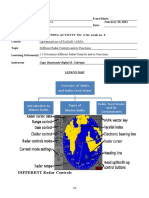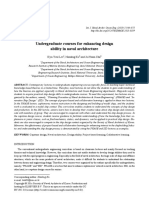0 ratings0% found this document useful (0 votes)
89 viewsBANWAS
BANWAS
Uploaded by
sureen123The document discusses a bridge navigational watch alarm system (BNWAS) that monitors bridge activity and detects if the officer of the watch becomes incapacitated. The BNWAS has three modes of operation and issues visual and audible alarms at set intervals if the officer does not acknowledge the system. International regulations require certain cargo and passenger ships constructed after 2011 to have a BNWAS, with deadlines for older ships depending on their size and type. The system is designed to alert backup officers or the master if the initial officer does not reset the alarms during stages of increasing urgency.
Copyright:
© All Rights Reserved
Available Formats
Download as PPTX, PDF, TXT or read online from Scribd
BANWAS
BANWAS
Uploaded by
sureen1230 ratings0% found this document useful (0 votes)
89 views5 pagesThe document discusses a bridge navigational watch alarm system (BNWAS) that monitors bridge activity and detects if the officer of the watch becomes incapacitated. The BNWAS has three modes of operation and issues visual and audible alarms at set intervals if the officer does not acknowledge the system. International regulations require certain cargo and passenger ships constructed after 2011 to have a BNWAS, with deadlines for older ships depending on their size and type. The system is designed to alert backup officers or the master if the initial officer does not reset the alarms during stages of increasing urgency.
Original Description:
BANWAS
Copyright
© © All Rights Reserved
Available Formats
PPTX, PDF, TXT or read online from Scribd
Share this document
Did you find this document useful?
Is this content inappropriate?
The document discusses a bridge navigational watch alarm system (BNWAS) that monitors bridge activity and detects if the officer of the watch becomes incapacitated. The BNWAS has three modes of operation and issues visual and audible alarms at set intervals if the officer does not acknowledge the system. International regulations require certain cargo and passenger ships constructed after 2011 to have a BNWAS, with deadlines for older ships depending on their size and type. The system is designed to alert backup officers or the master if the initial officer does not reset the alarms during stages of increasing urgency.
Copyright:
© All Rights Reserved
Available Formats
Download as PPTX, PDF, TXT or read online from Scribd
Download as pptx, pdf, or txt
0 ratings0% found this document useful (0 votes)
89 views5 pagesBANWAS
BANWAS
Uploaded by
sureen123The document discusses a bridge navigational watch alarm system (BNWAS) that monitors bridge activity and detects if the officer of the watch becomes incapacitated. The BNWAS has three modes of operation and issues visual and audible alarms at set intervals if the officer does not acknowledge the system. International regulations require certain cargo and passenger ships constructed after 2011 to have a BNWAS, with deadlines for older ships depending on their size and type. The system is designed to alert backup officers or the master if the initial officer does not reset the alarms during stages of increasing urgency.
Copyright:
© All Rights Reserved
Available Formats
Download as PPTX, PDF, TXT or read online from Scribd
Download as pptx, pdf, or txt
You are on page 1of 5
The purpose of a bridge navigational watch alarm system (BNWAS) is to monitor bridge activity and
detect operator disability which could lead to marine accidents.
The system monitors the awareness of the Officer of the Watch (OOW) and automatically alerts the
Master or another qualified OOW if for any reason the OOW becomes incapable of performing the OOWís
duties. This is achieved through a mix of alarms and indications which alert backup OOWs as well as the
Master.
BNWAS warnings are given in the case of incapacity of the watchkeeping officer due to accident, sickness
or in the event of a security breach, e.g. piracy and/or hijacking. Unless decided by the Master only, the
BNWAS shall remain operational at all time
The BNWAS primarily has three modes of operation:
•Automatic
•Manual ON
•Manual OFF
Alarms and Indications
1.Once the BNWAS is put into operation, the dormant period should be between 3 to 12 minutes. This dormant
period is the time in which the BNWAS is active without giving any alarm and it only once the dormant period is
over that the alarm is sounded and the alarm/indication is sounded and the reset function needs to be activated
2.Once the dormant period ends, a visual indication (first stage; flashing indication) must be activated
indicating/demanding that the officer rest it, if available and active
3.If not reset within 15 seconds of the visual indication, an audible alarm is sounded (first stage)
4.If at the first stage the audible alarm is not reset, 15 seconds after the audible alarm, another audible alarm
(second stage; the sound should have its own characteristic tone or modulation intended to alert, but not to startle,
the OOW) is sounded in the backup officer’s and/or Master’s cabin
5.If at the second stage the audible alarm is not reset, 90 seconds after it, another audible alarm is sounded (third
stage; easily recognisable, indicates urgency, a volume sufficient for it to be heard throughout the locations above
and to wake sleeping persons) at the locations of further crew members capable of taking corrective actions
6.Except for passenger vessels, the second and third stage alarm can be combined to sound at all locations. If this
is applied, the third stage alarm may be omitted
7.For very large vessels, sufficient time of up to 3 minutes must be accounted for the backup officer or the Master
to the reach the Bridge to tend to the situation
Regulations for BNWAS
SOLAS Chapter V Regulation 19 states:
1.Cargo ships of 150 gross tonnage and upwards and passenger ships irrespective of size constructed on or
after 1 July 2011
2.Passenger ships irrespective of size constructed before 1 July 2011, not later than the first survey after 1 July
2012
3.Cargo ships of 3,000 gross tonnage and upwards constructed before 1 July 2011, not later than the first
survey after 1 July 2012
4.Cargo ships of 500 gross tonnage and upwards but less than 3,000 gross tonnage constructed before 1 July
2011, not later than the first safety survey after 1 July 2013
5.Cargo ships of 150 gross tonnage and upwards but less than 500 gross tonnage constructed before 1 July
2011, not later than the first survey after 1 July 2014
6.A BNWAS installed prior to 1 July 2011 may subsequently be exempted from full compliance with the
standards adopted by the organization, at the discretion of the Administration
Watch Safety System Sequence
Dormant Period
1. The watch officer in the wheelhouse has to press the button
on Timer Reset Panel or operate interfaced equipment at
certain intervals. (Dormant period, 3-12 min.)
Main Alarm Panel
You might also like
- White Lily - Ship's ParticularDocument1 pageWhite Lily - Ship's ParticularAYA ALHADITHEYNo ratings yet
- Code of Safe Working Practices for Merchant Seafarers: Consolidated edition (incorporating amendments 1-6)From EverandCode of Safe Working Practices for Merchant Seafarers: Consolidated edition (incorporating amendments 1-6)No ratings yet
- Introducing SIRE 2.0 Industry Associations Awareness Session - 6 MayDocument21 pagesIntroducing SIRE 2.0 Industry Associations Awareness Session - 6 Maysureen123100% (3)
- Bnwas 2Document22 pagesBnwas 2gopuNo ratings yet
- Lrit 1Document4 pagesLrit 1Nikhil C PanakNo ratings yet
- 5 False and Unwanted Radar ResponsesDocument20 pages5 False and Unwanted Radar ResponsesRoken Zgoul100% (1)
- Annex V Discharge Requirements For Website 3 PDFDocument1 pageAnnex V Discharge Requirements For Website 3 PDFMehmet AliNo ratings yet
- Bridge Equipment - Lrit: Long Range Identification and TrackingDocument4 pagesBridge Equipment - Lrit: Long Range Identification and TrackingSachin ChaudharyNo ratings yet
- 9 Oil Pollution Act of 1990Document6 pages9 Oil Pollution Act of 1990Ur Loafer MarinerNo ratings yet
- HOLLANDDocument229 pagesHOLLANDAoki Amirul100% (1)
- SOLAS VentilasjonDocument4 pagesSOLAS VentilasjonTrần Thắng Oscar TrầnNo ratings yet
- Hour 2. Weather, Seamanship and NavigationDocument31 pagesHour 2. Weather, Seamanship and NavigationKrisman Gelesah100% (1)
- Dock Regulation (1988) : Myanmar Excellent StarsDocument1 pageDock Regulation (1988) : Myanmar Excellent StarsKyaw Thura Win100% (1)
- International Convention On Tonnage Measurement of ShipsDocument18 pagesInternational Convention On Tonnage Measurement of ShipsReynald Jezreel Ramirez100% (1)
- AIS (Automatic Identification System)Document6 pagesAIS (Automatic Identification System)karunNo ratings yet
- CBT CD # 0043 Bilge Water SeparatorDocument2 pagesCBT CD # 0043 Bilge Water Separatorwuguobing4No ratings yet
- Collision Regulation Part 1 GeneralDocument19 pagesCollision Regulation Part 1 Generalaris renz sangalang100% (2)
- Actions To Be Taken On Receiving Storm WarningsDocument7 pagesActions To Be Taken On Receiving Storm WarningsKunal100% (1)
- Week 6-7 Ship Reporting SystemDocument29 pagesWeek 6-7 Ship Reporting SystemMarlon Jay BanlutaNo ratings yet
- MLC 2006 Office Word DocumentDocument2 pagesMLC 2006 Office Word DocumentHARSHADNo ratings yet
- Solas VDocument8 pagesSolas VDinca CristianNo ratings yet
- Weather RouteingDocument3 pagesWeather Routeingveronica100% (3)
- COLREG 72 - ExplainDocument5 pagesCOLREG 72 - Explainthaw koNo ratings yet
- Voyage Data RecordersDocument3 pagesVoyage Data RecordersS SanchitNo ratings yet
- BEQ Consolidated PDFDocument117 pagesBEQ Consolidated PDFShiv Ranjan100% (1)
- Vts PROCEDURESDocument26 pagesVts PROCEDURESAlexandro Vincente100% (1)
- Gapoy, Frednixen B. Learning - Module - NAV - 5 - Operational - Use - of - RADAR - ARPA - LO - No. - 1.3Document19 pagesGapoy, Frednixen B. Learning - Module - NAV - 5 - Operational - Use - of - RADAR - ARPA - LO - No. - 1.3Frednixen Bustamante GapoyNo ratings yet
- Action in Tropical Revolving StormDocument5 pagesAction in Tropical Revolving StormJoeven OquendoNo ratings yet
- 30wknm15 Week30 2015Document119 pages30wknm15 Week30 2015Kunal Singh100% (1)
- What Seafarers Should Do After The Vessel Receives Storm WarningDocument2 pagesWhat Seafarers Should Do After The Vessel Receives Storm WarningCyrus Bumalo100% (1)
- Shipborne Navigational Systems and EquipmentDocument10 pagesShipborne Navigational Systems and EquipmentAbdel Nasser Al-sheikh YousefNo ratings yet
- Doppler EffectDocument7 pagesDoppler EffectYugandhar VeeramachaneniNo ratings yet
- Different Gas Detection Meters Used On ShipDocument6 pagesDifferent Gas Detection Meters Used On ShipWilliam GonzalezNo ratings yet
- Required Pilot Boarding Arrangements For Cargo ShipsDocument3 pagesRequired Pilot Boarding Arrangements For Cargo Shipsandrew1970gNo ratings yet
- What Is Azipod Propulsion System On Ship Marine InsightDocument4 pagesWhat Is Azipod Propulsion System On Ship Marine InsightAffan Khalif100% (1)
- QA-17 COLREGS - Lights, Shapes & Sound SignalsDocument1 pageQA-17 COLREGS - Lights, Shapes & Sound SignalsDennis Kar100% (1)
- MSC.1-Circ.707 - Guidance To The Master For Avoiding DangerousSituations in Following and Quartering Seas (Secretariat) PDFDocument14 pagesMSC.1-Circ.707 - Guidance To The Master For Avoiding DangerousSituations in Following and Quartering Seas (Secretariat) PDFhugh7777No ratings yet
- Imo - Survey Guidelines Under The Harmonized System of Survey and Certification (HSSC) 2019Document222 pagesImo - Survey Guidelines Under The Harmonized System of Survey and Certification (HSSC) 2019s0606No ratings yet
- IMO - Special Areas Under MARPOLDocument2 pagesIMO - Special Areas Under MARPOLaloordominic100% (1)
- IMPA Guidance On The Master - Pilot Exchange (MPX)Document8 pagesIMPA Guidance On The Master - Pilot Exchange (MPX)Manoj TyagiNo ratings yet
- Demonstrate The Allocation, Assignment and Prioritization of ResourcesDocument4 pagesDemonstrate The Allocation, Assignment and Prioritization of ResourcesLone Mark KoKo Boiser100% (1)
- 1726815848chief Mate Orals Function 1 FAQ Notes Updated Till July24Document51 pages1726815848chief Mate Orals Function 1 FAQ Notes Updated Till July24Karthi SundaramoorthyNo ratings yet
- Orals Func1Document15 pagesOrals Func1Jithin VaralilNo ratings yet
- Ship Operation Technology - (Factory Act)Document45 pagesShip Operation Technology - (Factory Act)Jayesh Solaskar100% (1)
- IMO CodesDocument3 pagesIMO CodesRahulNair100% (1)
- Capt. Muduli Answers by Sreekar Duppalli Fun 1-1Document105 pagesCapt. Muduli Answers by Sreekar Duppalli Fun 1-1Pawan KumarNo ratings yet
- SARTDocument1 pageSARTnauval.arch100% (1)
- Oral Question DeckDocument23 pagesOral Question DeckreiNo ratings yet
- SOLAS V Reg 19Document5 pagesSOLAS V Reg 19ABDUL ALIM100% (1)
- Ballast Water Management PDFDocument16 pagesBallast Water Management PDFAnkit Kale100% (1)
- MGN 128 (M+F) : Navigation in The Dover StraitDocument4 pagesMGN 128 (M+F) : Navigation in The Dover StraitgeorgesagunaNo ratings yet
- S5.11 UKC and Air DraftDocument8 pagesS5.11 UKC and Air DraftzikriNo ratings yet
- Guide Port ProcDocument10 pagesGuide Port ProcbhaveshchavdaNo ratings yet
- COMPETENCE: Respond To A Distress Signal KUP: Knowledge of The Contents of TheDocument34 pagesCOMPETENCE: Respond To A Distress Signal KUP: Knowledge of The Contents of Theduckerz28100% (2)
- SSBT W BRM Day 2 Rev 000Document46 pagesSSBT W BRM Day 2 Rev 000Joseph Raluta100% (1)
- IMO Res A.893 (21) Voyage PlanningDocument5 pagesIMO Res A.893 (21) Voyage PlanningRosca Liviu100% (1)
- Bridge Navigational Watch Alarm System Group 8Document13 pagesBridge Navigational Watch Alarm System Group 8Cezar M. Barranta Jr.No ratings yet
- Unit - 2 Types of Alarms on Ships-convertedDocument33 pagesUnit - 2 Types of Alarms on Ships-convertedAshmit DograNo ratings yet
- Bridge Navigational Watch Alarm System (Bnwas) : PurposeDocument6 pagesBridge Navigational Watch Alarm System (Bnwas) : PurposeSatya Prakash BhardwajNo ratings yet
- Bridge Navigational Watch Alarm SystemDocument18 pagesBridge Navigational Watch Alarm SystemKarl Kerl Tulang100% (2)
- 9.3BNWAS UMS Deadman Alarm SystemDocument15 pages9.3BNWAS UMS Deadman Alarm SystemJoyce DsouzaNo ratings yet
- 661_EXTENSIVE_DAMAGE_TO_FOUR_WEB_FRAMES_IN_NO._3_TOP_SIDE_TANK_(P)Document3 pages661_EXTENSIVE_DAMAGE_TO_FOUR_WEB_FRAMES_IN_NO._3_TOP_SIDE_TANK_(P)sureen123No ratings yet
- air vents classDocument7 pagesair vents classsureen123No ratings yet
- TAP5-793-10-1Document7 pagesTAP5-793-10-1sureen123No ratings yet
- CasualtyInformation_2011_03Document2 pagesCasualtyInformation_2011_03sureen123No ratings yet
- History Notes Revised FinalDocument88 pagesHistory Notes Revised Finalsureen123100% (1)
- Automatic Operation of Steering GearDocument10 pagesAutomatic Operation of Steering Gearsureen123100% (1)
- Standard Cargo Hold PreparationDocument32 pagesStandard Cargo Hold Preparationsureen123100% (1)
- Australian Quarantine and Inspection ServiceDocument17 pagesAustralian Quarantine and Inspection Servicesureen123No ratings yet
- Bulk Carrier Casualty ReportDocument28 pagesBulk Carrier Casualty Reportsureen123No ratings yet
- MPA No - 6 - of - 2019Document3 pagesMPA No - 6 - of - 2019sureen123No ratings yet
- Asm PolarDocument5 pagesAsm Polarsureen123No ratings yet
- GPSDocument149 pagesGPSVivek Gill100% (2)
- Ship Construction 2ND MatesDocument2 pagesShip Construction 2ND Matessureen123No ratings yet
- Ship Construction - 2ND MateDocument19 pagesShip Construction - 2ND Matesureen123No ratings yet
- posidonia2022_e-brochure_r8_waDocument9 pagesposidonia2022_e-brochure_r8_waashrisaNo ratings yet
- Cruise Industry DevelopmentsDocument2 pagesCruise Industry DevelopmentsMaritoni MedallaNo ratings yet
- CV - Achmad Widianto - CEDocument2 pagesCV - Achmad Widianto - CEwaalilu914No ratings yet
- F-139 Certificate of Sea ServiceDocument2 pagesF-139 Certificate of Sea Servicecarlos julioNo ratings yet
- Midterm - Styles of ShipDocument60 pagesMidterm - Styles of ShipJoseph Louis BautistaNo ratings yet
- MidshipDocument31 pagesMidshipapi-27176519100% (2)
- Instant Download Time Series; A First Course with Bootstrap Starter; Edition 1 Tucker S. McElroy & Dimitris N. Politis PDF All ChaptersDocument24 pagesInstant Download Time Series; A First Course with Bootstrap Starter; Edition 1 Tucker S. McElroy & Dimitris N. Politis PDF All Chaptersnehmehkoita100% (1)
- Ports and Docks (TOOOT !!)Document14 pagesPorts and Docks (TOOOT !!)moodyayan123No ratings yet
- Singapore Modul OneDocument6 pagesSingapore Modul OneNanang fatriadin100% (1)
- Ever Given - Investigation ReportDocument68 pagesEver Given - Investigation ReportMaciej ReichelNo ratings yet
- Duties and Responsibilities of PersonnelDocument9 pagesDuties and Responsibilities of PersonnelKyla ResuelloNo ratings yet
- List Transhipment Mv. Bulk JoyanceDocument1 pageList Transhipment Mv. Bulk JoyanceDani FirnandaNo ratings yet
- ZAFER, Bulk Carrier - Details and Current Position - IMO 9579315 - VesselFinder 2Document1 pageZAFER, Bulk Carrier - Details and Current Position - IMO 9579315 - VesselFinder 2zgspxrzky6No ratings yet
- 034D529592 - ChennaiDocument2 pages034D529592 - Chennai201 TVNo ratings yet
- Searches Export Search Results 2023 05 15 - 06 46Document4 pagesSearches Export Search Results 2023 05 15 - 06 46trisula watchlistNo ratings yet
- M O Monthly Publications Check List For Med Black Red SeaDocument3 pagesM O Monthly Publications Check List For Med Black Red SeaardiansyahraniNo ratings yet
- Chartering TypesDocument13 pagesChartering Typesนัทเดช เรืองสวนNo ratings yet
- MSN 1718Document2 pagesMSN 1718Syamesh SeaNo ratings yet
- Nav 04 - Pilot CardDocument4 pagesNav 04 - Pilot CardCORIN EDWARD100% (1)
- N P Glory 6Document1 pageN P Glory 6Albert TunNo ratings yet
- Litonjua Shipping V National Seamen BoardDocument1 pageLitonjua Shipping V National Seamen BoardVener Angelo MargalloNo ratings yet
- CURICULLUM VITAE JokoDocument1 pageCURICULLUM VITAE Jokojuprixu88No ratings yet
- Portable Fire Extinguisher Check List: MV Setia Indah / 9 M G P 5Document1 pagePortable Fire Extinguisher Check List: MV Setia Indah / 9 M G P 5Kunal SinghNo ratings yet
- Enhancing Design AbilityDocument12 pagesEnhancing Design AbilityOsama AlssalmanNo ratings yet
- Questions - Week 1Document7 pagesQuestions - Week 1Mahmoud ZaGHloul100% (1)
- CV Ku IniDocument1 pageCV Ku IniYoga AriffandiNo ratings yet
- Full City EngDocument59 pagesFull City EngLyubomir IvanovNo ratings yet
- Merchant Shipping Notice No.09 of 2014: Sub: International Safety Management (ISM) Code On Indian Ships-RegDocument38 pagesMerchant Shipping Notice No.09 of 2014: Sub: International Safety Management (ISM) Code On Indian Ships-RegVaibhav MoreNo ratings yet
- Ingilizce 68 Tum SorularDocument68 pagesIngilizce 68 Tum SorularAli KoçNo ratings yet








































































































